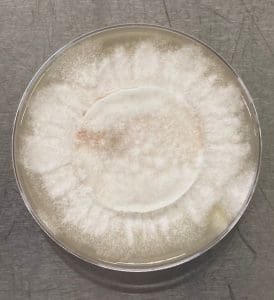AATCC 30 Antifungal Assessment and Mildew Resistance Test
Get A Testing Quote
 The AATCC 30 method, titled “Antifungal Activity, Assessment on Textile Materials: Mildew and Rot Resistance of Textile Materials” is designed to determine how susceptible textile materials (cloth, gauze, or similar objects) are to mildew and fungal growth and evaluate the efficacy of the fungicides applied to the selected materials.
The AATCC 30 method, titled “Antifungal Activity, Assessment on Textile Materials: Mildew and Rot Resistance of Textile Materials” is designed to determine how susceptible textile materials (cloth, gauze, or similar objects) are to mildew and fungal growth and evaluate the efficacy of the fungicides applied to the selected materials.
The AATCC 30 (Test III) method evaluates the aesthetic degradation of textiles or other absorbent materials resulting from fungal growth and provides qualitative results on a macroscopic and microscopic scale. This method is ideal for fabric products undergoing R&D antimicrobial fungal testing.
Summary of the AATCC 30 (Test III) Method
- A culture of Aspergillus niger ATCC 6275 is initiated and allowed to grow for approximately 14 days, upon which the spores are harvested and diluted to an appropriate concentration for use in testing.
- Test articles such as fabrics and other thin, absorbent materials are prepared to approximately 3.8 cm ± 0.5 cm in diameter.
- Controls articles are prepared in the same fashion and treated under the same parameters as the test articles.
- Test and control articles are wetted with a non-ionic wetting agent to aid in the absorption of the inoculum.
- Mineral Salts Agar plates are prepared per each test and control article, and each plate is evenly inoculated with 0.500 mL of inoculum before test and control article placement.
- Once test and control articles have been placed on their respective agar plates, the test and control articles are inoculated with 0.200 mL of inoculum.
- The specimens are incubated at 30 oC ± 2oC for 14 days.
- Upon completion of the incubation period, photographs are taken, and each article is qualitatively assessed for growth.
- Growth is evaluated macroscopically with the unaided eye, and microscopically, with a 10X microscope, and growth ratings are assigned.
Strengths of the AATCC 30
- The AATCC 30 test is a test that evaluates the antifungal capabilities of the test substance under fairly stringent conditions.
- This makes it a good indicator of antifungal efficacy, compared to other, relatively less stringent methods.
- The test substance comes into contact with a high number of spores for increased efficacy.
- A more definitive test than many other fungal methods, any inhibition of growth shown in this test is due to the antimicrobial effect of the test substance rather than the inability of the fungus to find nutrients and grow.
- Quicker incubation period than other fungal test methods (14 days vs. 28 days).
- This test method caters to fabrics with the incorporation of the non-ionic wetting agent.
- Inoculum contacts both faces of the material, allowing for full absorption into the fabric.
Weaknesses of the AATCC 30
- The stringency of the test might overwhelm milder antifungal agents.
- Inherent variability in spore concentration can lead to increased variability when running the test, as the AATCC 30 does not require the spore suspension to be standardized.
- Thick materials may limit access of the fungal spores from the top inoculated face of the material from accessing the mineral salts agar to allow for growth.
- This standard test method is limited to one fungus, Aspergillus niger ATCC 6275.
- The results of this test are qualitative and do not measure the exact concentrations of growth inhibition or quantitative assessments of sample degradation.
